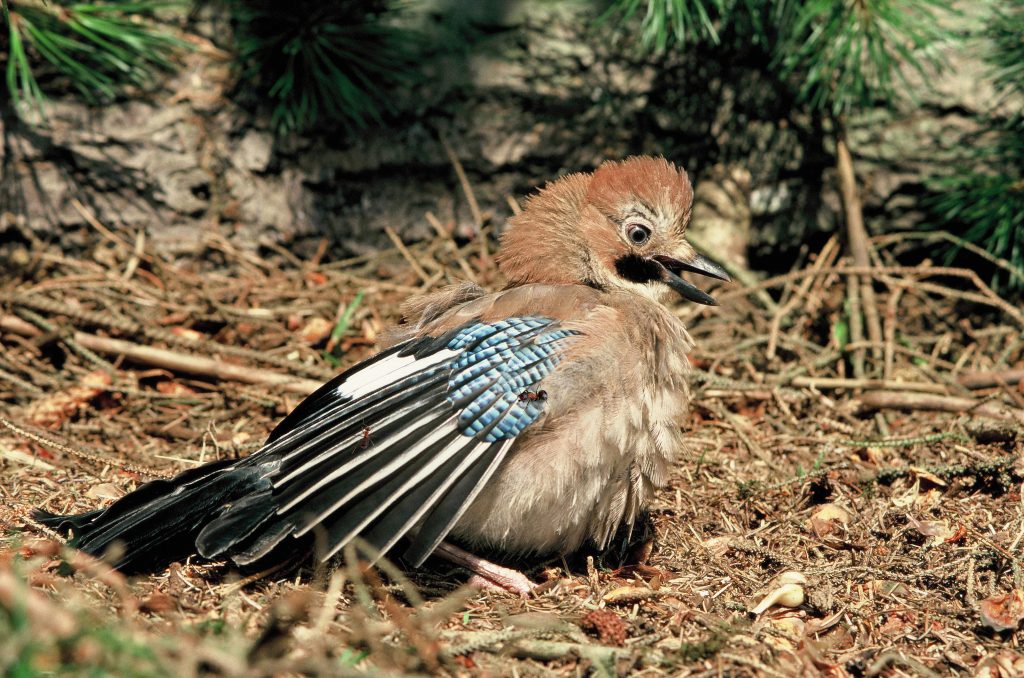Enjoying a Natural Spa
At last Spring is in the air. Sometimes damp, sometimes sunny, here in the relatively mild South West of England with so many public paths available, we are spoilt for choice. Especially if owned by the Forestry Commission, National Trust or County Wildlife Trust, all offer a wide and towering choice of walks from sea coast to high moor. Dogs on short leads of course at this time of the year. Not only to protect farm animals with young but also increasingly rare ground nesting birds.
At this time of the year, conifer forests especially benefit from the low sun, sending shafts of brightness streaming between the trees. Here the light and warmth often stir a small army. Busy little creatures emerging from their winter spent hiding underground. The Southern Wood Ant is common across England and Wales. Best left alone, they are still fascinating to watch from a safe distance, but mind not to step on their bustling ant trails. Larger than their garden cousins, they are one of the biggest in Britain, capable of inflicting a ferocious bite with their formidable, over-sized mouth parts. Industrious and well organised their nests can reach over a metre high and several paces wide. Their huge dome shaped mounds made of grass, small twigs or conifer needles. Built in a sunlit glade, some half a million workers and perhaps a hundred queens busy laying eggs. Each female is capable of producing a hundred eggs or more. Aggressively territorial, wood ants will attack and remove others of their kind from the immediate area. But these busy little creatures spend more time climbing high, tending countless mini herds of carefully farmed aphids. A small insect they milk for honey dew. Wood ants are armed, actively defending their aphids from other predatory insects or spider. Apart pincer like jaws they have another, even more effective defence – formic acid. A chemical they can spray with great accuracy, containing a powerful irritant with antimicrobial properties.
A tactic that one bird has learnt to exploit. The Jay is loud, colourful and clever. A member of the crow family with a predilection for acorns, that they eat or pluck and plant every year. Millions of them. Although jays do not always remember where they cached their food. So, many acorns grow where they were hidden. The bird is also a talented mimic, using the skill if threatened, to imitate the call of a sparrowhawk, tawny owl or even a domestic cat. So, it is not surprising the Jay has also learnt another clever trick. Finding an active ant nest, they pick up and place individual insects on their feathers, bathing in the toxic spray. A technique that seems to keep feathers clean and healthy. Indeed, Jays relish this natural spa so much, they appear to go into a trance. With feathers raised and wings spread, they dance around the wood ants’ nest. Perhaps leaving the birds feeling equally restored and rejuvenated.
Andrew Cooper
At this time of the year, conifer forests especially benefit from the low sun, sending shafts of brightness streaming between the trees. Here the light and warmth often stir a small army. Busy little creatures emerging from their winter spent hiding underground. The Southern Wood Ant is common across England and Wales. Best left alone, they are still fascinating to watch from a safe distance, but mind not to step on their bustling ant trails. Larger than their garden cousins, they are one of the biggest in Britain, capable of inflicting a ferocious bite with their formidable, over-sized mouth parts. Industrious and well organised their nests can reach over a metre high and several paces wide. Their huge dome shaped mounds made of grass, small twigs or conifer needles. Built in a sunlit glade, some half a million workers and perhaps a hundred queens busy laying eggs. Each female is capable of producing a hundred eggs or more. Aggressively territorial, wood ants will attack and remove others of their kind from the immediate area. But these busy little creatures spend more time climbing high, tending countless mini herds of carefully farmed aphids. A small insect they milk for honey dew. Wood ants are armed, actively defending their aphids from other predatory insects or spider. Apart pincer like jaws they have another, even more effective defence – formic acid. A chemical they can spray with great accuracy, containing a powerful irritant with antimicrobial properties.
A tactic that one bird has learnt to exploit. The Jay is loud, colourful and clever. A member of the crow family with a predilection for acorns, that they eat or pluck and plant every year. Millions of them. Although jays do not always remember where they cached their food. So, many acorns grow where they were hidden. The bird is also a talented mimic, using the skill if threatened, to imitate the call of a sparrowhawk, tawny owl or even a domestic cat. So, it is not surprising the Jay has also learnt another clever trick. Finding an active ant nest, they pick up and place individual insects on their feathers, bathing in the toxic spray. A technique that seems to keep feathers clean and healthy. Indeed, Jays relish this natural spa so much, they appear to go into a trance. With feathers raised and wings spread, they dance around the wood ants’ nest. Perhaps leaving the birds feeling equally restored and rejuvenated.
Andrew Cooper



